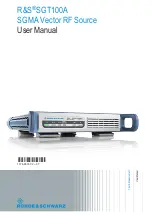
8.
Clear the MCA, Collect a new spectrum for 500 live seconds, and record the
net area of source the 1173.2 keV
60
Co reference peak.
9.
Compare the net area of the 1173.2 keV
60
Co peak acquired in step 6 and
compute the percentage change.
10.
If improvement is needed, try adjusting the LT TRIM slightly and repeat
steps 6 through 9 until an optimum setting is achieved. The LT Trim function
is located on the Gain Device Adjust screen. The value can be
decremented/incremented over a range of 0 to 1000 using the adjust slide bar
(the default setting is 250).
Note:
Lowering the LT Trim value will increase the system dead time and counts in
the reference peak area at high count rates.
Since the detector-source geometry was maintained and the preset Live Collection
time was held constant, the
60
Co (1173.2 keV) net area can be used as a standard when
comparing the effect of adding background counts Cs
137
(661 keV).
11.
Set the LTC ON/OFF switch to Off. Repeat steps 4 through 9. Compare the
deviation of source “A’s” spectrum when the LTC is ON and the LTC is
OFF.
With the LTC OFF, large changes will be observed in the reference net peak are as a
function of count rate. With the LTC set ON, changes in the reference peak net area
will be significantly reduced. The Live Time corrector extends the collection time
compensating for signal processing time and events rejected due to pileup.
Note:
Performance may vary and is dependent on factors such as spectrum energy
distribution, detector characteristics such as geometry, size, and detector bal-
listic deficit.
PUR Guard
The PUR Guard Time (GT) function is provided to optimize the performance of the
Pileup Rejector. The pile up reject interval is defined as GT x T
R
+T
Flat Top
where:
GT = PUR Guard Time selection; 8 selections ranging from 1.1 to 2.5 are
provided
T
R
= Filter Rise Time selection
T
Flat Top
= Filter Flat Top selection
User’s Manual - ICN 9231014G
51
PUR Guard
















































